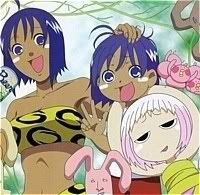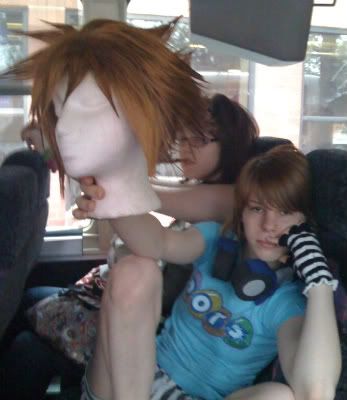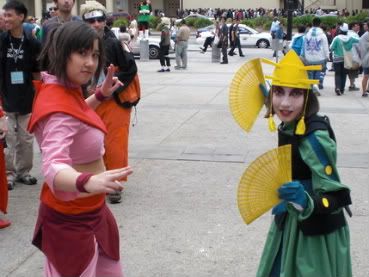A Look at the Humor of “Haré + Guu”
September 17th, 2008Some months ago, I wrote in my Avatar retrospective that the humor in anime comedies just could not compare to that of our domestic cartoons. The Japanese and Americans have two different senses of humor, which are buried deep into our cultural upbringing. Domestic cartoons featured more sarcasm and cynicism into their humor, which are both concepts not that prevalent in Japanese culture. On the other hand, anime comedies feature a lot jokes from the tsukkomi-boké formula, where a straight man (tsukkomi) punishes the stupidity of an idiot (boké). While tsukkomi-boké can translate to a vaudevillian slapstick to an American viewer, it mostly fails to produce the same kind of laughter as it does in Japan.
Well, not long after I wrote that, I came across one anime show that completely blew this generalization right out the window. At the start of August, I signed up for Fios TV service in my apartment, and much to my surprise, it came with the FUNimation Channel. Now, the FUNimation Channel is still very new, and from what I hear, it’s only available over Fios. That is why it is no surprise that the channel only appears to air about a dozen shows on repeat. But even with the limited selection of shows, they had one that I’ve been meaning to watch for a while now, Haré + Guu.
 Haré + Guu is the story of boy named Haré who lives in a small jungle village with his mother, Weda. After a night of partying, Weda unexplainably brings home an adorable pink-haired girl named Guu to live with them. But after a while, Haré discovers that Guu is not at all what she appears to be, and she makes his world a nightmare with all her crazy antics. The original Japanese title, Jungle wa Itsumo Hare Nochi Guu, is a play on Haré’s name meaning “sunny and nice” and can be interpreted as “the jungle was always nice, and then along came Guu.”
Haré + Guu is the story of boy named Haré who lives in a small jungle village with his mother, Weda. After a night of partying, Weda unexplainably brings home an adorable pink-haired girl named Guu to live with them. But after a while, Haré discovers that Guu is not at all what she appears to be, and she makes his world a nightmare with all her crazy antics. The original Japanese title, Jungle wa Itsumo Hare Nochi Guu, is a play on Haré’s name meaning “sunny and nice” and can be interpreted as “the jungle was always nice, and then along came Guu.”
And my God, this show is funny!
It is really f@#$ing funny!
It is the funniest anime I have ever seen and clearly does not just play into the traditional tsukkomi-boké formula. There is something very unique about this show that you don’t get with other Japanese comedies. So this week, I’d like to take an analytical look at the humor of this show and why it translates so well even to this American otaku.


